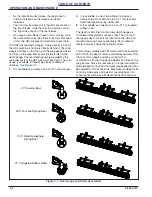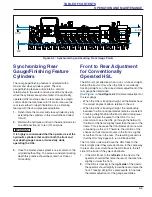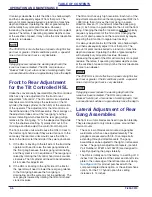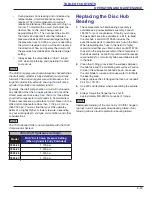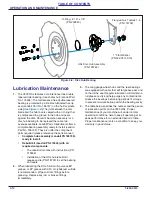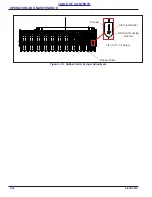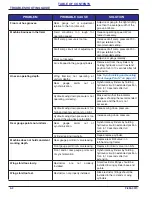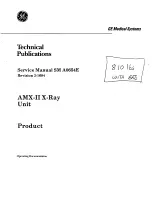
4-4
F-894-0919
OPERATION AND MAINTENANCE
IMPORTANT
Make sure the front gauges are synchronized and
leveled to enable the HSL to work the soil to uniform
depth of cut, across the entire machine.
The HSL has been adjusted prior to being shipped, but it
is appropriate to re-check it. Please consult the following
instructions and diagrams to check, or to re-set the
synchronization and levelness of the front gauges should
that become necessary.
NOTE
You will need the open end 2-5/8” wrench stored just
inside of the hitch left side brace tube, should adjustment
be necessary.
Follow the steps below when setting the front gauges.
1.
Retract the four (4) front gauge cylinders completely.
There are two (2) cylinders on the main hitch. There
is one (1) additional cylinder on each of the two (2)
wing frames.
•
Check that all of the polished chrome of the
cylinder rods is retracted into the cylinder body.
•
This procedure will require that the front gauge
depth control (on the hitch frame) is adjusted to
its most extreme depth setting.
•
If the cylinder rods are for some reason not
completely retracted, then fully extend the front
gauge cylinders until they are fully extended and
continue extending them for an additional five (5)
to ten (10) seconds after they appear to be fully
extended. This procedure will re-synchronize all
of the gauge cylinders. It is a good practice to
re-synchronize the front gauge cylinders once or
twice daily by extending them completely and
holding the circuit control in the extend position
for an additional five (5) to ten (10) seconds.
2.
The wheels and tires of the main frame hitch are not
adjustable. Leveling the front of the HSL from side to
side is accomplished by adjusting the wing front
gauge point. With the four (4) front gauge point
cylinders completely retracted, place a long straight
edge across the top of the center section frame.
Measure from the top of the hitch rockshaft spindle
bushings to the top of the top center section frame.
Confirm the distance to be approximately 3-1/4.
3.
For machines that have Goodyear 500/16.5 wing
gauge tires adjust the wing front gauge cylinder, base
end mount so that the distance from the wing frame
top, to the top of the wing gauge walking beam is 6”
more than the measurement confirmed in the
previous step. If the measurement in step two was
observed to be 3-1/4 inches, the wing gauge cylinder
base end mount will need to be adjusted until the
distance from the top of the wing frame to the top of
the wing gauge walking beam is 9-1/4 inches (3-1/4 +
6 = 9-1/4) when the cylinder is completely retracted.
If the wing gauge tires are Galaxy 32/1550 x 16.5,
then wing gauge cylinder, base end mount, will need
to be adjusted until the distance from the top of the
wing frame to the top of the wing gauge walking
beam is 5-5/8 inches more than the measurement
confirmed in step No. 2. So if the measurement in
step two was observed to be 3-1/4 inches, the wing
gauge cylinder base end mount will need to be
adjusted until the distance from the top of the wing
frame, to the top of the wing gauge walking beam, is
8-7/8 inches (3-1/4 + 5-5/8 = 8-7/8) when the cylinder
is completely retracted. If the wing gauge wheel tires
are BKT 410/50R16.5, then make the proper
adjustments so that distance from the top of the wing
frame to the top of the wing gauge walking beam is
5-7/8 inches more than the measurement confirmed
in step No. 2. So, if the measurement in step two was
observed to be 3-1/4 inches, then adjustments will
need to be made so that the distance from the top of
the wing frame to the top of the wing gauge walking
beam is 9-1/8 inches (3-1/4 + 5-7/8 = 9-1/8) when
the cylinder is completely retracted.
4.
Repeat this procedure for the other side wing of the
HSL.
5.
The final dimension can be affected by several
factors, including tire inflation, machine width, and
the wing down pressure setting. Expect the hitch tires
to squat slightly more than wing front gauge tires.
The final setting should be determined from field
observations. One of the simplest ways to observe if
the HSL is operating at a uniform working depth
across the entire machine, is to stop abruptly when
making a pass through a flat area and look along the
front or rear edge of the wing and center frames and
check for alignment. Checking the working depth
across the width of the machine is also
recommended.













